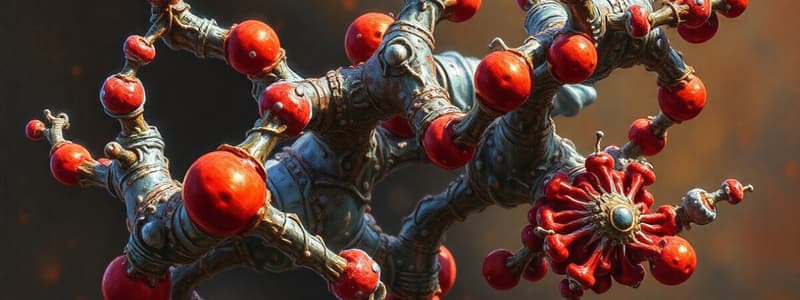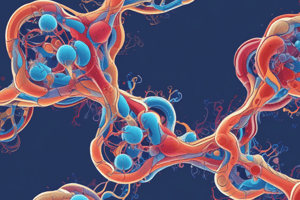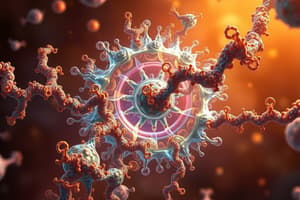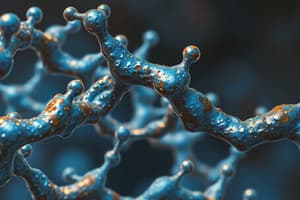Podcast
Questions and Answers
How does histidine function as an acid-base catalyst in enzymatic reactions?
How does histidine function as an acid-base catalyst in enzymatic reactions?
- It only functions in its non-ionized form to stabilize substrates.
- It always acts as a proton donor regardless of its ionized state.
- It exclusively acts as a proton sink without providing protons.
- It can serve as both a proton donor and proton acceptor depending on its ionization state. (correct)
Which amino acid is most likely a nucleophile in enzyme catalytic mechanisms?
Which amino acid is most likely a nucleophile in enzyme catalytic mechanisms?
- L-Cysteine
- Histidine
- L-Arginine
- L-Serine (correct)
What role does water serve in the enzymatic reaction involving serine as a nucleophile?
What role does water serve in the enzymatic reaction involving serine as a nucleophile?
- It participates in hydrolysis to generate the product. (correct)
- It stabilizes the enzyme-substrate intermediate.
- It serves as a proton donor to activate serine.
- It acts as a substrate to form the product.
Which of the following best describes the simultaneous use of acid and base catalysis in enzymes?
Which of the following best describes the simultaneous use of acid and base catalysis in enzymes?
In which situations would a serine residue be involved in the formation of covalent bonds with substrates?
In which situations would a serine residue be involved in the formation of covalent bonds with substrates?
Which statement correctly describes the role of enzymes in catalyzing reactions?
Which statement correctly describes the role of enzymes in catalyzing reactions?
What is the sequence of events in enzyme action?
What is the sequence of events in enzyme action?
What happens to the activation energy in the presence of an enzyme?
What happens to the activation energy in the presence of an enzyme?
What does the symbol ∆G represent in an enzymatic reaction?
What does the symbol ∆G represent in an enzymatic reaction?
Which property is true about enzymes in relation to substrates?
Which property is true about enzymes in relation to substrates?
What is the significance of the enzyme-substrate complex?
What is the significance of the enzyme-substrate complex?
Which of the following statements about enzyme specificity is correct?
Which of the following statements about enzyme specificity is correct?
Which factor does NOT affect the rate of an enzyme-catalyzed reaction?
Which factor does NOT affect the rate of an enzyme-catalyzed reaction?
Which amino acid acts as a nucleophile in the mechanism for chymotrypsin?
Which amino acid acts as a nucleophile in the mechanism for chymotrypsin?
What role does Histidine play in the mechanism of chymotrypsin?
What role does Histidine play in the mechanism of chymotrypsin?
Which of the following statements about chymotrypsin's mechanism is false?
Which of the following statements about chymotrypsin's mechanism is false?
What is the nature of the bond formed between the enzyme and the substrate during chymotrypsin's action?
What is the nature of the bond formed between the enzyme and the substrate during chymotrypsin's action?
In the chymotrypsin mechanism, which component is responsible for the formation of the tetrahedral intermediate?
In the chymotrypsin mechanism, which component is responsible for the formation of the tetrahedral intermediate?
Which of the following describes the ultimate fate of the tetrahedral intermediate formed during the chymotrypsin reaction?
Which of the following describes the ultimate fate of the tetrahedral intermediate formed during the chymotrypsin reaction?
Which amino acid primarily stabilizes the transition state during chymotrypsin's catalytic cycle?
Which amino acid primarily stabilizes the transition state during chymotrypsin's catalytic cycle?
During which step in the chymotrypsin mechanism does the enzyme undergo a significant conformational change?
During which step in the chymotrypsin mechanism does the enzyme undergo a significant conformational change?
What defines a reversible enzyme inhibitor?
What defines a reversible enzyme inhibitor?
Which statement about competitive inhibition is true?
Which statement about competitive inhibition is true?
How does sulfanilamide act as a competitive inhibitor?
How does sulfanilamide act as a competitive inhibitor?
Which type of inhibitor does not affect enzyme-substrate binding positively?
Which type of inhibitor does not affect enzyme-substrate binding positively?
What role does p-aminobenzoic acid (PABA) play in the action of sulfanilamide?
What role does p-aminobenzoic acid (PABA) play in the action of sulfanilamide?
Which statement about non-competitive inhibitors is correct?
Which statement about non-competitive inhibitors is correct?
What is a common characteristic of reversible enzyme inhibitors?
What is a common characteristic of reversible enzyme inhibitors?
Which of the following is an example of a reversible enzyme inhibitor?
Which of the following is an example of a reversible enzyme inhibitor?
What is the consequence of an allosteric inhibitor binding to an enzyme?
What is the consequence of an allosteric inhibitor binding to an enzyme?
Which characteristic defines transition-state inhibitors compared to regular substrates?
Which characteristic defines transition-state inhibitors compared to regular substrates?
What role do renin inhibitors play in the body?
What role do renin inhibitors play in the body?
Which statement about the induced fit model in enzymes is correct?
Which statement about the induced fit model in enzymes is correct?
What happens to the active site when an allosteric inhibitor binds?
What happens to the active site when an allosteric inhibitor binds?
Why can transition states not be isolated or synthesized?
Why can transition states not be isolated or synthesized?
What is a key property of allosteric inhibitors in relation to substrate concentration?
What is a key property of allosteric inhibitors in relation to substrate concentration?
What feature distinguishes the design of transition-state inhibitors from substrate analogs?
What feature distinguishes the design of transition-state inhibitors from substrate analogs?
Study Notes
Enzymes: Structure and Function
- Enzymes are special types of receptors that interact with substrates, forming complexes.
- Unlike other receptors, enzymes catalyze reactions, transforming substrates into products.
- Most enzymes are soluble and found in the cytosol of cells.
Enzymatic Reactions
- Steps:
- Substrate approaches the active site.
- Enzyme-substrate complex forms.
- Substrate transforms into products.
- Products are released.
- Enzyme is recycled.
Examples:
- Sucrase: Catalyzes the breakdown of sucrose into glucose and fructose.
- Protein Tyrosine Kinase: Catalyzes the phosphorylation of tyrosine residues in proteins using ATP as a phosphate source.
Enzyme Properties:
- Activation energy: Amount of energy needed to disrupt a stable molecule before the reaction can occur.
- Enzymes lower the activation energy, but the free energy change (ΔG) remains the same.
- Equilibrium constant (K) = [Product]/[Reactant]
Catalysis Mechanisms:
- Nucleophilic residues: Enzymes can use nucleophilic amino acid side chains (e.g., Serine or Cysteine) in the active site to form covalent bonds with the substrate.
- Acid/base catalysis: Enzymes can utilize acid and base catalysis simultaneously, utilizing the protonation and deprotonation properties of amino acid residues like histidine.
Example: Chymotrypsin Mechanism
- Chymotrypsin utilizes a catalytic triad consisting of Serine, Histidine, and Aspartate.
- The mechanism involves a series of steps involving nucleophilic attack, proton transfer, and release of the product.
Enzyme Inhibitors:
- Reversible Enzyme Inhibitors: Slow down or block enzyme catalysis by reversibly binding to the active site.
- Competitive inhibition: Inhibitor competes with the substrate for binding to the active site.
- Non-competitive inhibition: Inhibitor binds to a site other than the active site, altering the enzyme's shape and preventing substrate binding.
- Example: Sulfonamides are competitive inhibitors of dihydrofolate synthetase, an enzyme involved in folic acid biosynthesis.
- Irreversible Inhibitors: Bind irreversibly to the active site, permanently inactivating the enzyme.
- Allosteric Inhibitors: Bind to a site other than the active site (allosteric site), causing a conformational change that alters the active site, preventing substrate binding.
Transition-State Inhibitors:
- Designed to mimic the transition state of an enzyme-catalyzed reaction.
- Since transition states are high-energy and transient, transition-state inhibitors bind more strongly than substrate or product analogs.
- Example: Renin inhibitors, which mimic the transition state of the reaction catalyzed by renin, are used as antihypertensives to lower blood pressure.
Studying That Suits You
Use AI to generate personalized quizzes and flashcards to suit your learning preferences.
Related Documents
Description
Test your knowledge on enzymes, their structure, function, and the enzymatic reaction process. This quiz covers key concepts like substrate interaction, activation energy, and examples of specific enzymes like sucrase and protein tyrosine kinase. Perfect for students studying biochemistry or related subjects.




